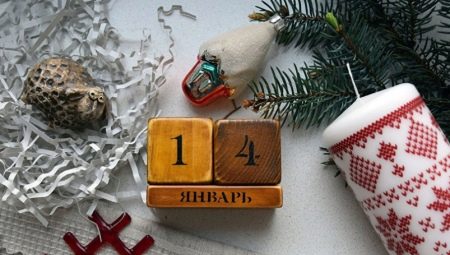Where did the old New Year holiday come from?

Old New Year is a rather interesting phenomenon, an additional holiday that was the result of a change in the chronology system. Due to the significant discrepancy between the calendars used, Russians meet the New Year twice - according to the new style, and then again, according to the old one. In our review, we will tell you more about the features of this day, the history of its origin and the ancient traditions of celebrating the day with such an unusual name.


What is Old New Year?
At midnight from January 13 to January 14, the New Year comes into force according to the previous calendar or, more precisely, according to the Julian style. In the old days, the time was determined precisely according to this chronological system - it was based on data collected by astronomers of Ancient Alexandria. The system was introduced into mass use in 45 BC. NS. Guy Julius Caesar. The duration of the Julian year averaged 365.25 days, which was 11 minutes longer than the total duration of the astronomical year - which is why, over time, the Julian time frame moved ahead of the astronomical points of the spring and autumn equinox.
In order to eliminate inconsistencies, a new chronology system was proposed - the Gregorian calendar, which approached the tropical year as closely as possible due to the formation of a system of leap years.
The length of the year and according to the Gregorian chronology is 365.2425 days.

In different states, the transition to the Gregorian calendar stretched over several centuries. So, on the territory of Western Europe, they switched to it only in 1582, and in Russia the modern chronology system was officially approved and only in 1918.
It is this calendar that is used today in everyday life and according to it we celebrate the New Year's holiday on January 1. It so happened that our grandparents, accustomed to the old calendar, continued to celebrate the New Year in the old style. Over time, it grew into a good habit, and the old New Year, celebrated on the night of January 13-14, became another unofficial holiday.


History of origin
Such an ambiguous, contradictory and seemingly meaningless phrase "old New Year" has become so familiar that almost no one remembers what day it was and where it came from. The tradition of celebrating this day came from believers. The fact is that the Orthodox Church in 1918 refused to obey the decree of the Soviet government and continued to rely in its calculations on the Julian calendar. That is why in our country Orthodox Christmas falls not on December 25, but on January 7. And the New Year, in accordance with tradition, begins after Christmas - that is, on the night of January 13-14. The Russian Orthodox Church gives several serious reasons to preserve the Julian calendar.

Firstly, the very concept of time is quite relative, and the presence of such a factor as the precession of the earth's axis makes any attempts to combine any calendar day with the day of the spring or autumn equinox completely meaningless.
Because of the precession, this point is constantly moving along the ecliptic towards the west, that is, it goes towards the apparent movement of the Sun.


That is why, in fact, the date of the vernal equinox is different every year, and for the purposes of astronomy it is calculated every time according to a new one. However, in fairness, it should be noted that the Julian calendar does not claim to exactly match its calendar dates with the tropical year. - the creators laid spiritual goals in it rather than intending to solve astronomical problems.
Secondly, the Orthodox claim that the Gregorian calendar is characterized by great variability. It is extremely inconvenient to calculate the onset of religious holidays using it, since the length of the quarters differs here - it ranges from 90 to 92 days. In the Gregorian calendar, the first half of the year is always shorter than the second, and the days of the week often do not coincide with the constant dates.

Finally, the main stumbling block was associated with the day of the celebration of Easter. Back in 325, the holy fathers of the 1st Ecumenical Council, on the basis of the sequence of events related to the death and resurrection of Jesus Christ described in the Gospel, made sure that the New Testament Easter did not depend on the Old Testament and was always celebrated later. However, according to the Gregorian calendar, Christian Easter sometimes occurs simultaneously with the Old Testament, or even a little earlier. It is characteristic that the descent of the Holy Fire in the Church of the Holy Sepulcher in Jerusalem usually takes place on the day of Orthodox Easter, which is celebrated according to the Julian calendar, and not with the Catholic one, established in accordance with the Gregorian calendar.
At the time of the adoption of the Gregorian calendar, the lag between the systems was 10 days. However, due to the different number of leap years in each century, it changed - today the gap between the two calendars is already 13 days, and in the future it will only increase. Some believe that the old New Year is celebrated exclusively in the Russian Federation, Ukraine and Belarus. In practice, this is far from the case - this day is celebrated with great pomp in Montenegro, Serbia and Macedonia, it is also expected in Armenia and Georgia.
The inhabitants of the Baltic countries and Asian states - Kazakhstan, Turkmenistan and Uzbekistan do not forget to celebrate the old New Year in accordance with the Julian calendar.


Traditions in the world and in Russia
The day of January 14 for the believing Christians of our country coincides with a great religious holiday - the Orthodox honor the memory of St. Basil. This date in the past was called Vasilyev's Day, he played a huge role in the events of the entire subsequent period. For a long time it was customary to celebrate the old New Year on a grand scale - at a laid table, in new clothes and with the kindest thoughts. It is no coincidence that the saying appeared: "As you celebrate the New Year, you will spend it." This day would always be a truly family holiday; on Vasilevsky evening, people asked forgiveness from their relatives and friends for the wrongs caused to them, and then made their deepest desires.

In the villages and villages on this day there were carols - in accordance with customs, singers were presented with sweets, and children were fed with dumplings... It was on the old New Year that Orthodox people could afford to relax, as it coincided with the end of the Nativity Fast. The night from 13 to 14 January coincides with Christmastide, which is why unmarried girls on this night wondered about their lover and the wedding. Young people on this day jumped over the fire - in accordance with popular beliefs, this way you can burn all bad energy and cleanse a person from all bad influences and evil thoughts.

Several prohibitions apply to this day.
- You should not celebrate the old New Year in shabby or dirty clothes - otherwise, you will wear rags all year round.
- There is no need to scold and quarrel - otherwise all the negative energy from the thrown words will return back to the person who said them.
- If you give money to borrow money for the old New Year, then financial success will leave home for a long time.
- It is impossible for a woman to cross the threshold of the house on the very first morning of January 14 - according to legends, this attracts trouble. And if a man enters the dwelling first, this, on the contrary, will attract success and happiness to the family.



There are several more signs associated with the celebration of the second New Year.
- If in the morning of January 14 a person from a large family comes to visit you, then your life will be prosperous.
- If the night on Vasilyev's day is starry, expect a bountiful harvest of fruits and berries, and if it starts snowing in the evening, this is a good harvest of cereals.
- If you meet the old New Year on a grand scale, then the whole year will pass the same way.
- Hearing an unusual ringing in the morning on the old New Year - to replenish the family.



About where the old New Year holiday came from, see the next video.

